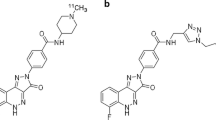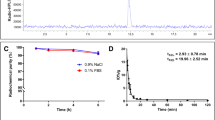Summary
The potential of99mTc labeled P1, P4-di (adenosine-5’)-tetraphosphate (Ap4A) for imaging experimental atherosclerotic plaques was evaluated in New Zealand white (NZW) rabbits. To label the99mTc to Ap4A, stannous tartrate solution was used.99mTc-Ap4A was purified on a Sephadex G-25 column. The radiochemistry purities of99mTc-Ap4A were 85% to 91%. Biodistribution study revealed99mTc-Ap4A cleared from blood rapidly. Thirty min after99mTc-Ap4A administrated on NZW atherosclerotic rabbits, lesion to blood (target/blood, T/B) ratio was 3.17±1.27, and lesions to normal (target/non-target, T/NT) ratio was 5.23±1.87. Shadows of atherosclerotic plaques were clearly visible on radioautographic film. Aortas with atherosclerotic plaques also could be seen on ex vivo gamma camera images. Atherosclerotic abdominal aortas were clearly visible on in vivo images 15 min to 3 h after99mTc-Ap4A administration.99mTc-labeled Ap4A can be used for rapid noninvasive detection of experimental atherosclerotic plaque.
Similar content being viewed by others
References
Guo Y. The Animal Models of Human Disease (Chinese). Beijing: Peolples Health Publication, 1982. 129–134
Grundy S M. Atherosclerosis imaging and the future of lipid management. Circulation, 2004, 110 (23): 3509–3511
Rapaport E, Zamecnik P C. Presence of diadenosine 5’, 5"-P1, P4-tetraphosphate (Ap4A) in mammalian cells in levels varying widely with proliferative activity of the tissue: a possible positive “pleiotypic activator”. Proc Natl Acad Sci USA, 1976, 73 (11): 3984–3988
Narula J, Virmani R, Iskandrian A E. Strategic targeting of atherosclerotic lesions. J Nucl Cardiol, 1999, 6: 81–90
Pintor J, Miras-Portugal M T. Diadenosine polyphosphates (APXA) as new neurotransmitters. Drug Dev Res, 1993, 28: 259–262
Elmaleh D R, Narula J, Babich J Wet al. Rapid noninvasive detection of experimental atherosclerotic lesions with novel99mTc-labeled diadenosine tetraphosphates. Proc Natl Acad Sci U S A, 1998, 95: 691–695
Zhang Y X, Wu Z J, Cao W. Radioiodine labeled SP-4 as an imaging agent for atherosclerotic plaques. Nucl Sci Tech, 2000, 11 (4): 234–239
Author information
Authors and Affiliations
Additional information
Cao Wei, male, born in 1970, Doctor in Charge
This project was supported by a grant from National Natural Sciences Foundation of China (No. 30070310).
Rights and permissions
About this article
Cite this article
Wei, C., Yongxue, Z. & Rui, A. Evaluation of99mTc labeled diadenosine tetraphosphate as an atherosclerotic plaque imaging agent in experimental models. J. Huazhong Univ. Sci. Technol. [Med. Sci.] 26, 278–280 (2006). https://doi.org/10.1007/BF02829550
Received:
Issue Date:
DOI: https://doi.org/10.1007/BF02829550




